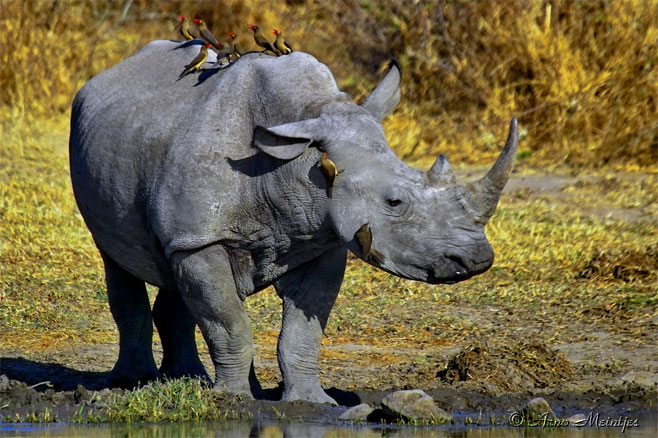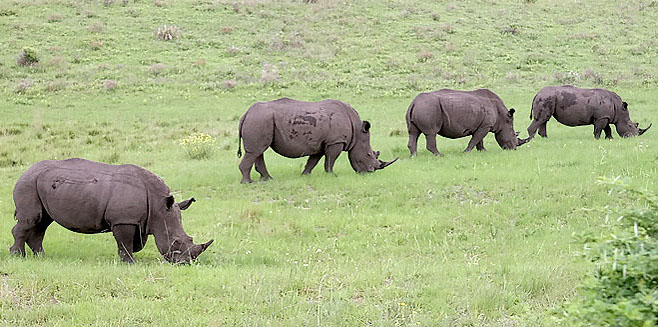|
Ceratotherium simum
(Square-lipped rhinoceros, White rhinoceros)
square-lipped rhinoceros, grass rhinoceros [English]; witrenoster [Afrikaans];
Witrenoster, Breitmaulnashorn [German]; rhinocÍros blanc [French]; kiaru ya
majani [Swahili] umkhombo omhlophe [isiNdebele]; umkhombe [isiXhosa] [siSwati];
ubhejane omhlophe [isiZulu] [Sesotho]; t'shukudu, mogohu [Sepedi]; tshukudu,
mogohu, tshukudu e molomo o sephara [Sesotho]; kgetlwa, tshukudu, mogohu [Setswana];
chipembere [Shona]; mhelembe [Xitsonga]; tshugulu [Tshivenda]
Life
>
Eukaryotes >
Opisthokonta >
Metazoa (animals) > Bilateria > Deuterostomia >
Chordata > Craniata > Vertebrata (vertebrates) >
Gnathostomata (jawed vertebrates) > Teleostomi (teleost
fish) > Osteichthyes (bony fish) > Class:
Sarcopterygii (lobe-finned fish) > Stegocephalia
(terrestrial vertebrates) > Reptiliomorpha > Amniota >
Synapsida (mammal-like reptiles) > Therapsida > Theriodontia
> Cynodontia > Mammalia (mammals)
> Placentalia (placental mammals) >
Laurasiatheria > Ferungulata > Paraxonia > Perissodactyla (odd-toed
ungulates) > Family: Rhinocerrotidae
(rhinoceroses)
 |
|
Square-lipped rhinoceros with Red-billed oxpeckers,
Kruger National Park, South Africa. [photo Arno Meintjes
©] |
 |
|
White rhinoceros grazing, Greater St. Lucia
Wetland Park, KwaZulu-Natal, South Africa. [photo
Jeff Poklen
©] |
Identification
The square-lipped or white rhinoceros is the
largest of the 5 existing rhino species and the third largest land
mammal. The skin colour is grey, and there is a distinctive large
hump on the neck. The head is long and carried low ending in a broad
square muzzle, with two horns above the nose usually the front horn
is longer. The rhinoceros gets its name from the Greek meaning
“nose-horn”. The rhino’s horn has no core and consists of an
aggregation of hair-like keratin fibres attached to the skin and
seated on a roughened area of the nasal region of the skull. Short
stout limbs support the animal’s massive weight and the feet have 3
digits. The common name “white” is actually derived from the Dutch
for “wide”, an early description of the characteristic mouth shape.
The rhino is one of Africa’s “Big Five”.
Size
Height at shoulder 1.8 m; weigh range
2000 – 2 300 kg (male) and 1400 – 1600 kg (female).
Dental formula
I C C P P M M =
24 =
24
Gestation
16 months
Distribution and habitat
Previously had a wide distribution but
limited to reserves and game farms. It generally prefers dry savanna woodland,
short-grassed areas with thick bush cover and water.
General behaviour
Rhino’s have poor vision and are unable to see
a motionless person at 30 m. However, there sense of smell is
excellent. In contrast to the black rhino the white rhino is mild
and inoffensive in nature, and is easily frightened off.
Square-lipped rhino cannot survive in arid
habitats as they are dependant on upon water and drink almost daily.
They also use waterholes for wallowing, and coat themselves in mud.
It is thought that the mud serves to protect the animal against
biting insects. Although rhino’s have thick hides, the blood vessels
lie just below the thin outer layer.
Male rhino’s are solitary and territorial.
While often solitary female white rhino will form family groups with
other females and their young.
Food
A grazer, favours feeding on short grass.
Reproduction
White rhino mothers will stand
protectively over their calf when threatened. Calves are vulnerable
to attack by many predators including lions and hyenas. The white
rhino calf walks in front of its mother. After a gestation period of
16 months, they are born but will stay with their
mother’s for 2-3 years, until shortly before the birth of the next
offspring when she will drive them away.
Life span
45 years
Conservation
The rapid decline in numbers of both
African rhino species is a result of extensive poaching for their
horns. Their conservation status is critically endangered and all
rhino are listed on CITES Appendix 1. The horns are sold on the
black market, most go to Yemen and Asia. In Yemen the horns are
carved into dagger handles, and in Asia they are ground for use as
traditional medicine. The best chance for survival seems to lie in
armed protection, their attraction in terms of tourist revenue and
protection in nature reserves and parks.
Text by Denise Hamerton |
